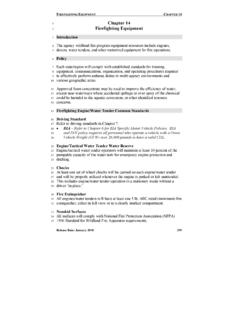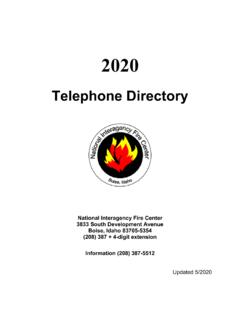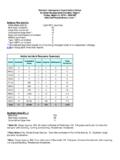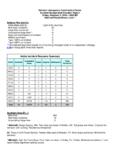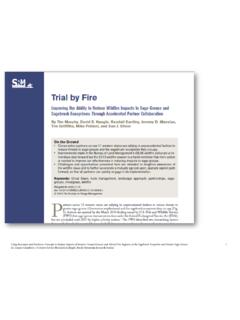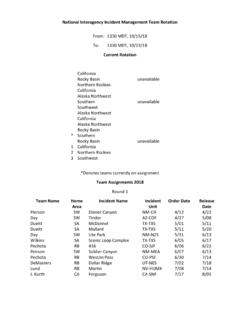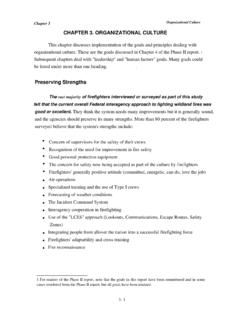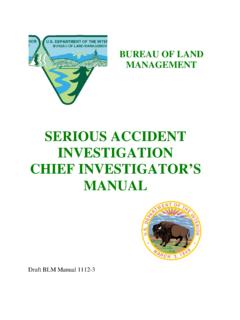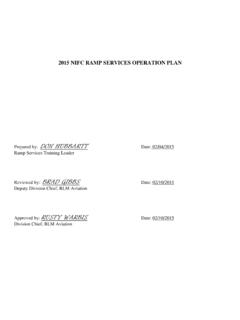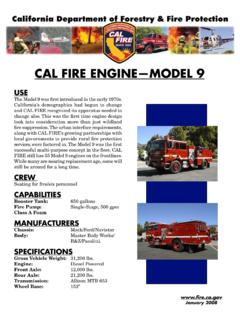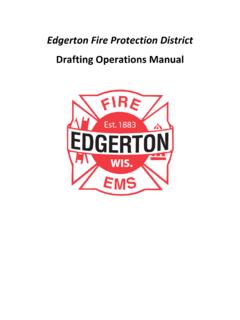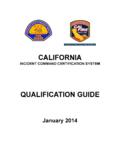Transcription of Chapter -14, Firefighting Equipment
1 Firefighting Equipment Chapter 14 Release Date: January 2012 14-1 Chapter 14 1 Firefighting Equipment 2 3 Introduction 4 5 The agency wildland fire program Equipment resources include engines, dozers, 6 water tenders, and other motorized Equipment for fire operations. 7 8 Policy 9 10 Each state/region will comply with established standards for training, 11 Equipment , communications, organization, and operating procedures required to 12 effectively perform arduous duties in multi-agency environments and various 13 geographic areas. 14 15 Approved foam concentrate may be used to improve the efficiency of water, 16 except near waterways where accidental spillage or over spray of the chemical 17 could be harmful to the aquatic ecosystem, or other identified resource concerns.
2 18 19 Firefighting engine /Water Tender Common Standards 20 21 Driving Standard 22 Refer to driving standards in Chapter 07. 23 24 engine /Tactical Water Tender Water Reserve 25 engine /Tactical Water Tender Operators will maintain at least 10 percent of the 26 pumpable capacity of the water tank for emergency engine protection and 27 drafting. 28 29 Chocks 30 At least one set of wheel chocks will be carried on each engine /water tender and 31 will be properly utilized whenever the engine is parked or left unattended. This 32 includes engine /water tender operation in a stationary mode without a driver in 33 place . 34 35 fire Extinguisher 36 All engines/water tenders will have at least one 5 lb. ABC rated (minimum) fire 37 extinguisher, either in full view or in a clearly marked compartment.
3 38 39 Nonskid Surfaces 40 All surfaces will comply with National fire Protection Association (NFPA) 41 1906 Standard for Wildland fire Apparatus requirements. 42 43 44 45 Chapter 14 Firefighting Equipment 14-2 Release Date: January 2012 First Aid Kit 1 Each engine /water tender shall carry, in a clearly marked compartment, a fully 2 equipped 10-person first aid kit. 3 4 Gross Vehicle Weight (GVW) 5 Each engine and water tender will have an annually certified weight slip in the 6 vehicle at all times. Weight slip will show individual axle weights and total 7 GVW. Operators of engines and water tenders must ensure that the maximum 8 certified gross vehicle and axle weight ratings are never exceeded, including 9 gear, personnel, and fuel. The NFPA 1906 standard of 250 pounds per seat 10 position for each person and their personal gear will be used to calculate the 11 loaded weight.
4 12 FS - Refer to FSH , Chapter 30 for calculation of Rough Road 13 Factor reduction for driving on rough or unsurfaced roads. 14 NPS - A copy of the annual certified weight slip must be sent to the fire 15 Equipment and Facilities Specialist at the FMPC in Boise prior to the 16 vehicle being put into service each season. 17 18 Speed Limits 19 Posted speed limits will not be exceeded. 20 21 Lighting 22 Headlights and taillights shall remain illuminated at all times while the vehicle is 23 in motion. All new orders for fire engine apparatus will include an overhead 24 lighting package in accordance with agency standards. Lighting packages will 25 meet NFPA 1906 standards ( , 2006 edition). Engines currently in service 26 may be equipped with overhead lighting packages. A red, white, and amber 27 combination is the accepted color scheme for fire .
5 Lighting packages containing 28 blue lights are reserved for law enforcement and are not allowed on fire 29 vehicles. 30 31 Emergency Light Use 32 Emergency lighting will be used only during on site wildland fire operations or 33 to mitigate serious safety hazards. Overhead lighting and other emergency 34 lighting must meet state code requirements, and will be illuminated whenever 35 the visibility is reduced to less than 300 feet. 36 DOI- See agency chapters or policy for specific guidance. 37 FS- See FSM 5120 and 5130 for red lights and siren policy. 38 39 fire engine Maintenance Procedure and Record 40 Apparatus safety and operational inspections will be accomplished either on a 41 post- fire or daily basis. Offices are required to document these inspections. 42 Periodic maintenance (as required by the manufacturer) shall be performed at 43 the intervals recommended and properly documented.
6 All annual inspections 44 Firefighting Equipment Chapter 14 Release Date: January 2012 14-3 will include a pump gallons per minute (GPM) test to ensure the pump/plumbing 1 system is operating at desired specifications. 2 3 Firefighting Engines 4 5 Operational Procedures 6 All engines will be equipped, operated, and maintained within guidelines 7 established by the Department of Transportation (DOT), regional/state/local 8 operating plans, and procedures outlined in BLM Manual H-9216, fire 9 Equipment and Supply Management, or agency equivalent. All personnel 10 assigned to agency fire engines will meet all gear weight, cube, and manifest 11 requirements specified in the National Mobilization Guide. 12 13 engine Typing 14 engine typing and respective standards have been established by NWCG.
7 15 16 engine Type Components Structure Engines Wildland Engines 1 2 3 4 5 6 7 Tank Minimum Capacity (gal) 300 300 500 750 400 150 50 Pump Minimum Flow (gpm) 1000 500 150 50 50 50 10 @ Rated Pressure (psi) 150 150 250 100 100 100 100 Hose 2 1200 1000 - - - - - 1 500 500 1000 300 300 300 - 1 - - 500 300 300 300 200 Ladders per NFPA 1901 Yes Yes - - - - - Master Stream 500 gpm Min. Yes - - - - - - Pump and Roll - - Yes Yes Yes Yes Yes Maximum GVWR (lbs) - - - - 26,000 19,500 14,000 Personnel (NWCG min.) 4 3 3 2 2 2 2 FS - See for 17 description of Forest Service national engine standards. 18 19 20 Chapter 14 Firefighting Equipment 14-4 Release Date: January 2012 fire engine Staffing 1 An ENGB will be with every engine , and the minimum staffing is two 2 individuals for Type 4, 5, 6, 7, engines.
8 3 4 For Type 3 engines, minimum staffing is three individuals, including an engine 5 Boss. 6 BLM - For BLM engine staffing requirements, see Chapter 2. 7 FWS - Minimum staffing for Type, 6 and 7 engines (on Refuge lands) is one 8 ENOP and one FFT2. A minimum of one ICT5 must be available on the 9 engine crew. 10 NPS - For NPS engine staffing requirements see Chapter 3. 11 FS - A Single Resource Boss may supervise a type 6 or 7 engine . 12 13 engine Inventories 14 An inventory of supplies and Equipment carried on each vehicle is required to 15 maintain accountability and to obtain replacement items lost or damaged on 16 incidents. The standard inventory for engines is found in Appendix M. 17 18 Water Tenders 19 20 Water Tender Typing 21 Water tender typing and respective standards have been established by NWCG.
9 22 23 Requirements Water Tender Type Support Tactical S1 S2 S3 T1 T2 Tank Capacity (gal) 4000 2500 1000 2000 1000 Pump Minimum Flow (gpm) 300 200 200 250 250 @Rated Pressure (psi) 50 50 50 150 150 Max. Refill Time (mins) 30 20 15 - - Pump and Roll - - - Yes Yes Personnel (min) 1 1 1 2 2 24 25 26 27 28 Firefighting Equipment Chapter 14 Release Date: January 2012 14-5 Water Tender Staffing Standards 1 Water Tender (Non-Tactical) 2 o Qualifications: CDL (tank endorsement). 3 o Staffing: A water tender (non-tactical) may be staffed with a crew of 4 one driver/operator when it is used in a support role as a fire engine 5 refill unit or for dust abatement. These operators do not have to pass 6 the Work Capacity Test (WCT) but are required to take annual 7 refresher training.
10 8 Water Tender (Tactical) 9 Tactical use is defined as direct fire suppression missions such as pumping 10 hoselays, live reel use, running attack, and use of spray bars and monitors to 11 suppress fires . 12 o Qualifications: 13 BLM- ENOP, CDL (tank endorsement) 14 FS- FFT1, CDL 15 o Staffing: Tactical water tenders will carry a minimum crew of two: 16 BLM- One ENOP and One engine Module Member 17 FS- One FFT1 and One FFT1/FFT2 firefighter 18 19 Dozers/Tractor Plows 20 21 Dozer/Tractor Plow Training and Qualifications 22 Agency personnel assigned as dozer/tractor plow operators will meet the 23 training standards for a Firefighter 2 (FFT2). This includes all safety and annual 24 refresher training. While on fire assignments, all operators and support crew 25 will meet PPE requirements including the use of aramid fiber clothing, hard 26 hats, fire shelters, boots, etc.
